Coming never to a road near you: Five myths about autonomous vehicles
Whether you call them autonomous, self-driving or robot cars, there is a lot of discussion about when, where and how these vehicles will take to the roads.
A!ex looks like a regular crossover vehicle, but under—and on top of—its shiny white exterior, you’ll find the latest technologies, from radar to artificial intelligence. A!ex is a robot car used for multidisciplinary research at Aalto University that’s also contributing to a revolution in traffic systems.
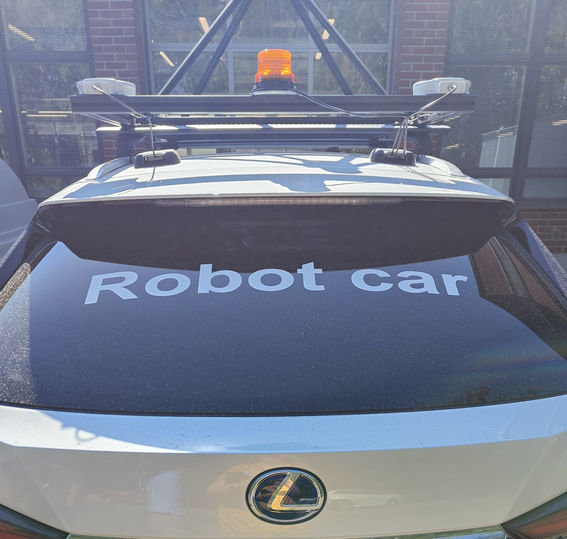
‘A!ex was a normal car that we equipped with high-quality sensors and localization, like cameras, LIDAR and a computer that runs our algorithms—and this is how it became a self-driving car,’ explains postdoctoral fellow Gökhan Alcan, one of the researchers from the School of Electrical Engineering who works on A!ex.
A!ex was outfitted for research use with a special software package—through this transformation, the normal-looking Lexus RX became a robot car. ‘Robot car’ is even written on its rear window, so others on the road recognize that behind the tinted windows, invisible forces are at the wheel rather than a human driver.
Well, except for the fact that there is a person sitting in the driver’s seat.
Finnish legislation allows for remote operation of a vehicle – a rarity in Europe. To test the robot car on public roads, the researchers had to spend several months getting a permit. They received permission, but they also promised the Finnish Transport and Communications Agency Traficom that the car would always have a safety driver. And there’s even a bright red emergency stop button in the car, should the need arise.
Laboratory manager Jesse Pirhonen from the School of Engineering is responsible for the different gadgets and software in A!ex, as well as for making sure that researchers who do tests with the car don’t fiddle with its basic settings or the work of other groups. But Pirhonen has also become quite familiar with sitting behind the wheel. He is one of three designated safety drivers who are allowed to cruise public roads with A!ex—though only in a limited area.
‘We drive A!ex on public roads to test and develop our algorithms, but mostly only here in the Otaniemi campus area,’ Pirhonen explains.
Other roads aren’t off-limits to A!ex, but a separate plan and prior agreement has to be made with Traficom.
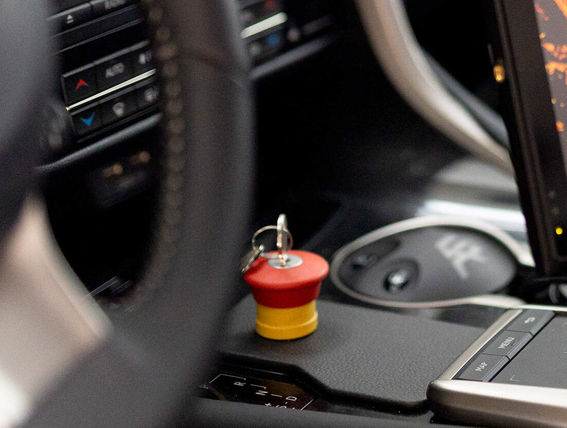
Alongside algorithms, A!ex gets moving thanks to a combination of multidisciplinary research and other invisible powers.
The emergency stop button is located where a gear stick would normally be. The safety driver can still change gears on the automatic transmission with a gear switcher if necessary. The self-driving car is not missing its steering wheel, but most of the vehicle’s control comes from highly tuned and continuously developing tech.
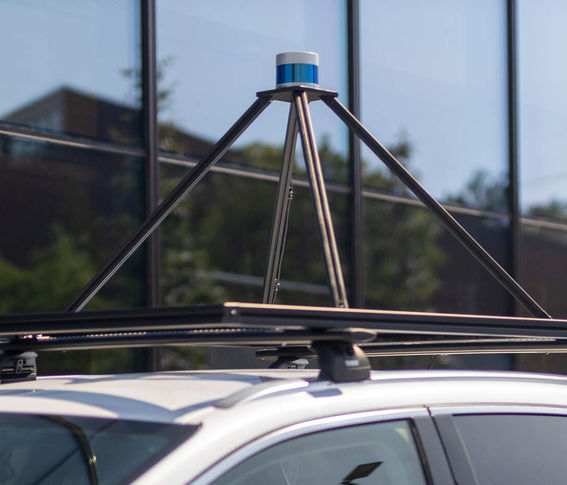
The trunk of the robot car houses a computer that runs its algorithms, as well as a power distribution system that sends electricity to the computer, sensors and screens in the car. The various cameras and sensors on A!ex send information to the computer for steering decision-making, while the laser scanner or LIDAR on the roof senses the surroundings, such as oncoming cars and pedestrians, and localizes the car.
The car’s controller then gets an algorithmic decision from the computer on how to proceed—maybe a surprising obstacle has appeared that requires stopping, for example.
Pirhonen and Alcan describe the two main research directions A!ex is used for. The first is to further develop the control of the vehicle; in other words, they’re looking for ways that A!ex could steer itself safely and completely independently. This requires improving the car’s decision-making capability: A!ex’s control algorithms are honed to make decisions with safety in mind.
And what about the other main research focus? Its goal seems nearly impossible: to get the robot car to see and sense well enough to make safe decisions in challenging weather conditions, like the Finnish winter.
Gökhan Alcan and Jesse Pirhonen are demonstrating A!ex the robot car and the associated research on a June day in Otaniemi. In the hot sun, frozen country roads and snow flurries are the last thing on anyone’s mind. But those are one big reason why robot cars aren’t yet seen on the roads of Finland.
Winter conditions are tough for any driver, not the least for robots relying on machine vision. Postdoctoral researcher Risto Ojala is looking for solutions to A!ex’s sensing and navigation in difficult conditions. He demonstrated a tool developed at Aalto designed to reduce the effect of weather on the sensors of robot cars.
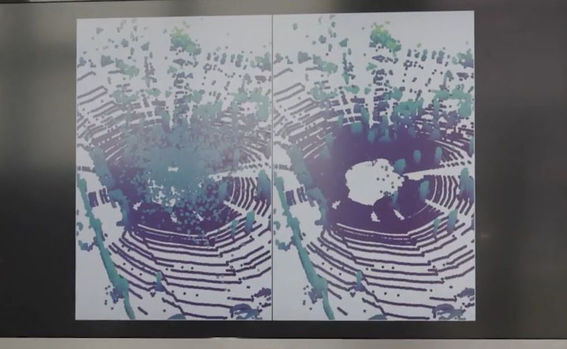
‘Snowfall is a central challenge for self-driving cars because it prevents sensors from seeing what’s around the car. LIDAR, for example, reflects “noise” from snowflakes and can’t sense the environment. Our group has developed an algorithm that allows us to mostly remove snowflakes from LIDAR data, so we can see the real environment instead of noise,’ Ojala explains.
Ojala strongly believes that self-driving cars will make it onto the roads in the future—even in Finland’s difficult winter conditions. But this is probably still far in the future, because first there has to be a technology breakthrough in easier, non-winter conditions. The obstacles or delays keeping robot cars back aren’t solely to do with technology, Ojala points out.
‘There are also legal questions related to autonomous driving. Even if self-driving cars were safer than cars driven by people, we find it hard to accept when a machine makes mistakes. People can’t accept that even one accident could happen because of an error by a self-driving car, even if the total proportion of accidents was smaller than with human-driven cars,’ says Ojala.
Robots driven by unseen forces have been used in industry for decades, but they’re also under constant development to become smarter and more autonomous. At the Aalto University Industrial Internet Campus (AIIC), the most visible sign of this R&D is Ilmatar, the smart crane that is the pillar of Aalto’s cooperation with Konecranes. A crane may sound like a dull thing to study, but for robotics and autonomy researchers, it is anything but.
‘It’s software, it’s smart devices, it’s everything you can expect from a modern autonomous machine and an intelligent system. When you think about it more closely, it’s a huge robot,’ says AIIC’s COO Jari Juhanko.
True to its name, the Industrial Internet Campus is characterised by two traits, says Juhanko: industrial and internet. The ‘industrial’ refers to the research environment of the smart crane, where the focus is on the needs of, and close collaboration with, the manufacturing industry. ‘Internet’ has to do with all the invisible powers needed get a smart crane moving.
‘Internet means connectivity. In other words, these devices can communicate with others by exchanging information. A simple example would be to share their own location, and anything else having to do with monitoring the robot’s condition and safety,’ says Juhanko.
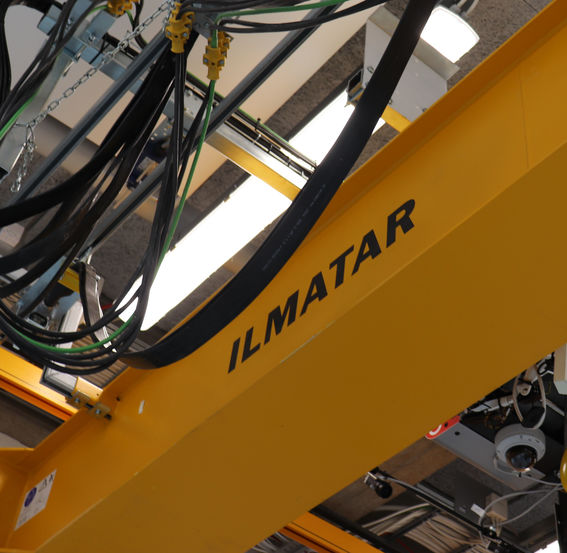
Beyond its technical features, research and operations around the smart crane are governed by invisible powers like different business models and regulations. The digitalisation of industry isn’t just about technology, says Juhanko, but also about getting all these factors to work together simultaneously.
‘If one element is missing, we end up with a table with legs of different lengths: it wobbles and will fall over at some point. The balance comes from all of these factors syncing up,’ Juhanko says.
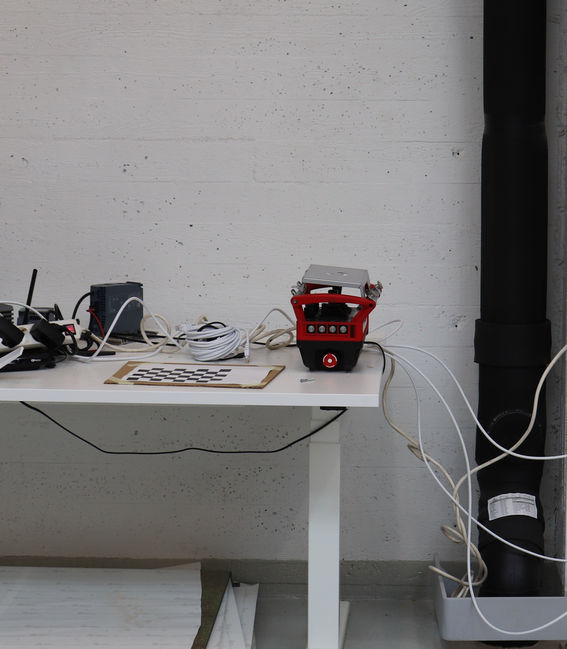
Just like A!ex, Ilmatar comes with various safety regulations, and Juhanko says that a top priority is that robots cannot harm people in any situation. In line with current regulations, research on the smart crane is done in a fenced area in the industrial lab.
‘The safety features don’t classify it as a cobot, a collaborative robot that could function fully autonomously with a person in the same space,’ explains Juhanko.
The smart crane is controlled through an open interface to the Konecranes system, which means it’s controlled by computer, but manual control is also possible using a radio controller – coloured red, just like the emergency stop button in A!ex. Ilmatar also has a camera so it can use machine vision to observe any obstacles in its environment, like a misplaced office chair—or a person.
If the connection to the robot is lost for some reason, the crane immediately stops, says Juhanko. If the crane is operated remotely, the connection must be constantly monitored. Everything must be followed closely so nothing dangerous happens, and this is where regulations governing industrial robots come into play.
‘More and more autonomy is needed, but how it is regulated is also changing. The kinds of safety factors that are required and accepted is a topic that’s under constant discussion,’ Juhanko says.
People can also delay and hinder the increase of autonomy in industrial settings, Juhanko points out.
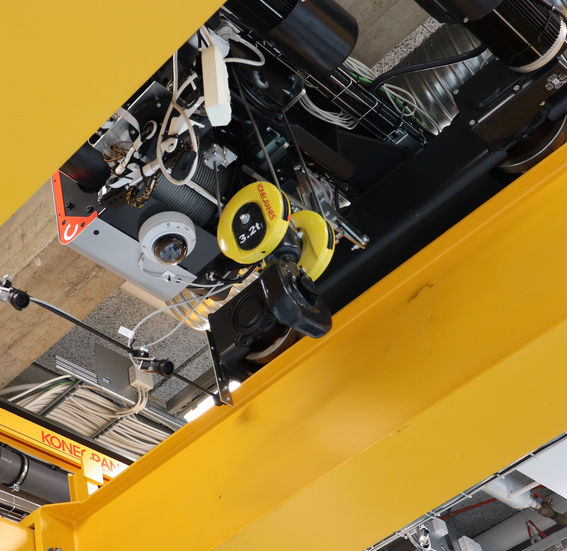
‘People have to accept a changing world. There is so much discussion about how robotics and autonomous machines will destroy jobs. At the same time, it’s known that the jobs replaced by robots are usually dull, monotonous, and repetitive, and those are the easiest to automate. Then there’s talk of a shortage of industrial workers—this can be a solution for that,’ Juhanko says.
Despite all its advanced tech and machine intelligence, Ilmatar the autonomous crane can’t function without some human intervention.
‘The only challenge is the traditional hook system. When something is hooked on and attached, you need human hands. Our plan, in collaboration with our partners, is to build a robot that could do this, too,’ says Juhanko.
In the future, Ilmatar might get loads to lift without the help of human muscle. And, as Risto Ojala hopefully predicted, some day—maybe quite far off still—the invisible challenges of self-driving cars will be solved, and they will become as commonplace as industrial robots. But for the time being, A!ex the robot car will travel the streets under the watchful eye of its small group of safety drivers.


Whether you call them autonomous, self-driving or robot cars, there is a lot of discussion about when, where and how these vehicles will take to the roads.

This white car may look like a regular SUV, but a closer examination reveals a laser scanner on its roof. Inside, it’s missing a gear stick, as A!ex shifts gears with the aid of an algorithm.

The development environment includes the Ilmatar crane and its digital twin. Many components of the digital twin can now be utilised in the development of new products and services for the crane – at any time and anywhere in the world.

